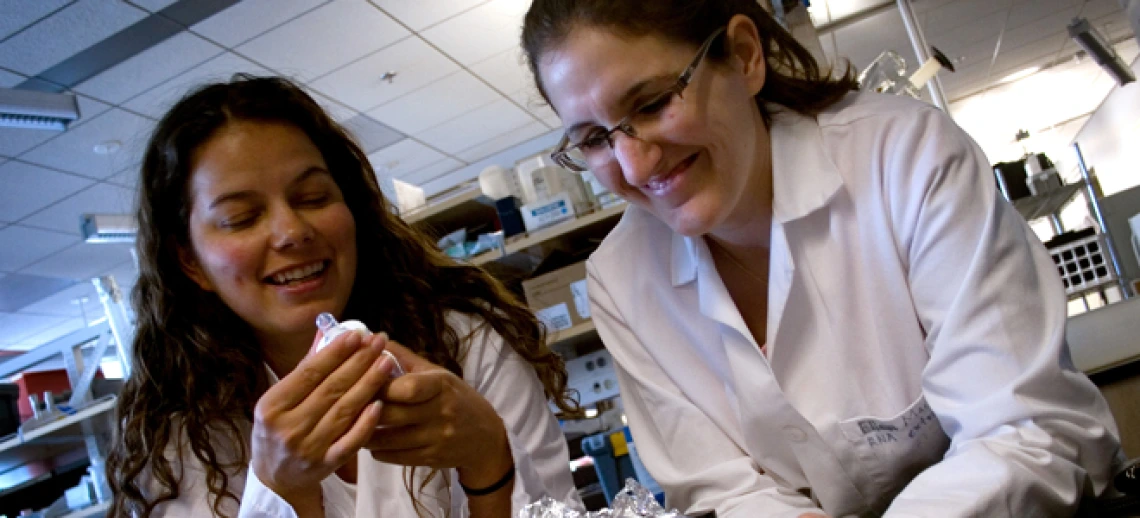Exploratory Study First to Quantify TCE in Breast Milk

 University of Arizona Superfund Research Program (UA SRP) investigators recently authored a study reporting on the levels of the environmental contaminant trichloroethylene (TCE) in breast milk. UA SRP Investigators Paloma Beamer (Mel and Enid Zuckerman College of Public Health), Eduardo Sáez (Chemical and Environmental Engineering), and Leif Abrell (Arizona Laboratory for Emerging Contaminants), as well as Swilma Campos (Mariposa Community Health Center as the community research partner ), María Elena Martínez (University of California, San Diego) and Catherine Luik (recent MPH graduate from College of Public Health), recently published the exploratory study in Environmental Science and Technology.
University of Arizona Superfund Research Program (UA SRP) investigators recently authored a study reporting on the levels of the environmental contaminant trichloroethylene (TCE) in breast milk. UA SRP Investigators Paloma Beamer (Mel and Enid Zuckerman College of Public Health), Eduardo Sáez (Chemical and Environmental Engineering), and Leif Abrell (Arizona Laboratory for Emerging Contaminants), as well as Swilma Campos (Mariposa Community Health Center as the community research partner ), María Elena Martínez (University of California, San Diego) and Catherine Luik (recent MPH graduate from College of Public Health), recently published the exploratory study in Environmental Science and Technology.
The study sampled breast milk from women in 20 households in Nogales, AZ, a city known to have TCE-contaminated groundwater. In addition, samples of water used for drinking, cooking, laundry, and bathing were collected and a risk factor questionnaire was administered. TCE was detected in seven of the 20 breast milk samples (35%), ranging from 1.5 to 6 ng/mL. TCE was detected in all water samples collected; TCE concentration in breast milk was significantly associated with the concentration of TCE in water used for bathing and laundry, but not drinking and cooking. TCE was more likely to be found in breast milk of mothers whose babies had a body mass index less than 14. Based on average breast milk consumption, TCE intake for 5% of infants may exceed the reference dose recommended by the United States Environmental Protection Agency (US EPA).
 TCE, used as a solvent in the past for many industrial and commercial applications, is the most frequently reported organic contaminant in groundwater and impacts communities across the country. For example, TCE and other chlorinated solvents are the primary contaminants of concern at an overwhelming majority of the state (31 out of 35) and federal (13/15) Superfund sites in Arizona. TCE exposure has been associated with increased risk of a variety of diseases, from autoimmune diseases such as lupus, to blood disorders and cancer. Maternal and early childhood exposures have been associated with increased risk of childhood cancers such as leukemia. Nogales, the largest border city in Arizona, is home to a 13-acre TCE plume, and faces a unique potential for additional TCE exposure from rapid growth of industrial production along the US-Mexico Border. Nogales was selected as the study site for this project because of existing TCE contamination and an increased prevalence of lupus and cancers associated with TCE exposure.
TCE, used as a solvent in the past for many industrial and commercial applications, is the most frequently reported organic contaminant in groundwater and impacts communities across the country. For example, TCE and other chlorinated solvents are the primary contaminants of concern at an overwhelming majority of the state (31 out of 35) and federal (13/15) Superfund sites in Arizona. TCE exposure has been associated with increased risk of a variety of diseases, from autoimmune diseases such as lupus, to blood disorders and cancer. Maternal and early childhood exposures have been associated with increased risk of childhood cancers such as leukemia. Nogales, the largest border city in Arizona, is home to a 13-acre TCE plume, and faces a unique potential for additional TCE exposure from rapid growth of industrial production along the US-Mexico Border. Nogales was selected as the study site for this project because of existing TCE contamination and an increased prevalence of lupus and cancers associated with TCE exposure.
The US EPA has identified quantification of TCE in breast milk as a high priority need for risk assessment. Says study author Paloma Beamer “the results of this exploratory study suggest that more in-depth studies will be important for understanding the risk to infants of TCE exposure via breast milk intake and how to reduce the mothers’ exposure.” In the meantime, all of the authors stress that mothers should continue to breastfeed their children to ensure critical health benefits for both mother and baby.

